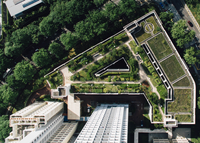Modern green roofs are coming back into style and it’s having a tremendous (positive) impact on our cities
Until the late 19th century, turf roofs were actually commonly used for homes, but they’ve gotten an upgrade since then. Now we’re seeing structural design come into play with turf roofs with the addition of drainage layers, irrigation system and multiple growing options, depending on the strength and design of the roof.
Ultimately, the purpose of turf roofs or rooftop gardens is to bring a bit of greenery into an urban space. This can be done on homes, apartments, malls, or any other building as long as the structure can be altered to sustain a green roof.
There are two types of roof gardens: extensive roof gardens, which require very little soil and are incredibly easy to maintain. As easy as they are, they’re not going to be your average “garden” that grows veggies and other plants that require deep soil. An extensive roof garden will grow crops like lichen, moss, wildflowers or succulents, whereas an intensive roof garden is what we normally picture when we hear “rooftop garden.” The vegetation will include flowers, trees, shrubs and other backyard plants, but this roof requires large, stable construction and is usually only possible on larger buildings and requires a bit more maintenance and an irrigation setup.
As complicated as installing a green roof may sound, the benefits definitely outweigh the disadvantages.
 Photo by CHUTTERSNAP on UnsplashThe benefits of more green roofs
Photo by CHUTTERSNAP on UnsplashThe benefits of more green roofs
They help with rainwater management
Flooding is becoming a major issue in certain regions due to climate change. With extreme weather events like storms comes heavy rainfall, and often our gutters, which overflow into sewers, can’t take the intense input. With fewer green spaces in cities, the water has nowhere to go and nowhere to be absorbed, but green roofs help reducing 75 percent of the water runoff during storms. The water becomes retained by the growing medium, and as the plants’ root systems develop, they’re able to retain even more water over time.
They control internal and external temperatures
The Urban Heat Island Effect is a very real thing in major cities, or in any urban area in the summer. Because the sun’s radiation is being absorbed by the paved surfaces, that radiation bounces back as heat and increases the local air temperature. Green roofs help absorb the heat and can cool a city by a few degrees or more if they’re added to at least half of a downtown surface. By lowering the temperature on the roof itself, it also decreases the amount of heat that goes into the building and cuts down on cooling costs and energy uses by 20 percent. Overall, green roofs are known to provide an extremely constant temperature throughout the year, where in the winter they keep the heat in, and in the summer provide a cool environment.
Extends the life of a building
The elements have been known to leave a harsh impact on buildings, leading to repairs and the use of more materials and resources over time. With a green roof shielding the top from the elements, and plants taking on the sun and water, the entire building is protected from physical damage. In Germany, where they installed rooftop gardens 50+ years ago, those same buildings have never experienced a leak. This can save municipalities and individuals billions of dollars in repairs, while also ensuring that we’re eliminating the overuse of finite resources and materials.
Creates a pollinator haven
Increasing green spaces in cities benefits our environment more than we’d think. As urban sprawl continues, species are being forced out of their homes and have less access to food that is normally found in fields and forests. Providing wilderness in an urban space can increase natural habitats for birds, squirrels and insects like butterflies and bees who play a vital role in our ecosystem. The more we can restore our biodiverse ecosystem, the more humans and our food production can thrive as well.
Improves our overall well-being
Natural spaces are known to promote mental wellness. By increasing the number of natural spaces in urban areas, we can see a huge boost in mental health, especially in having designated spaces in the city to help folks unwind and relax. Providing green space to those who don’t have cars and can’t travel outside to forests and parks is crucial in keeping nature accessible and available to everyone, not just a few. Rooftop gardens on apartments and within communities have been known to improve productivity, creativity and performance, while adding a beautiful and affordable building amenity that brings the community closer together.
By creating more green spaces on otherwise useless rooftops, we can transform our cities into productive and sustainable places that benefit everyone.
Additional sources: https://www.terracastproducts.com/5-surprising-benefits-adding-roof-garden/
https://greennova.eco/2021/10/08/advantages-and-disadvantages-of-green-roofs/

